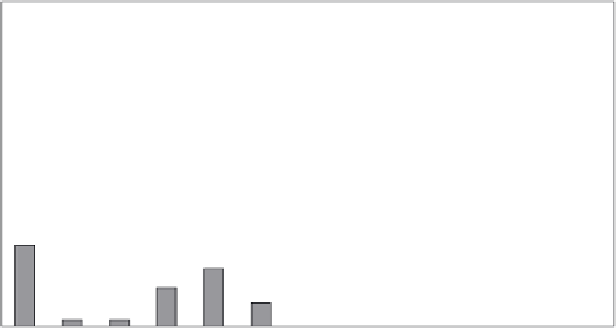Environmental Engineering Reference
In-Depth Information
in population (but a steady decline in the population growth rate), with the population
expected to reach between 8 and 10.5 billion in the year 2050 (IDB 2010).
The worldwide consumption of pesticides is about 2 million tons per year, of which 24%
is consumed in the United States alone, 45% in Europe, and 25% in the rest of the world.
India's share, for example, is just 3.75%. The usage of pesticides in India is only 0.5 kg/ha,
while in Korea and Japan, it is 6.6 and 12.0 kg/ha, respectively (Gupta 2004).
At present, approximately 1500 active ingredients have been registered as pesticides,
and the formulators mix these compounds with one or more of some 900 “inert” ingredi-
ents to create approximately 50,000 commercial pesticides registered for use. Roughly, 85%
of the pesticides currently used in the world are devoted to the agricultural sector; almost
10% are dedicated to sanitary measures against vectors in public health programs, and the
rest are applied in specific sites such as buildings, transport media, and residential areas
(WHO 1993).
Data on pesticide consumption in three continents, expressed as intensity (metric
tons/hectare, MT/ha) (WRI 1996), reveal that the most intensive pesticide users among
Latin American countries are Costa Rica and Belize (18.0 and 17.4 MT/ha, respectively),
followed by Trinidad and Tobago (13.3 MT/ha). In 1990, Brazil consumed the highest
quantity (67,000 MT) in 61,350 hectares; achieving, however, the lowest intensive pesti-
cide use in the continent (1.1 MT/ha). Pesticide consumption data (mostly for the year
1992) collected from WRI (1996) based on FAO and other sources are presented for some
African countries in Figure 15.1. With intensity expressed in terms of metric ton per
cropped hectare, Morocco (9.9 MT/ha), Tanzania (4.2 MT/ha), Burundi (3.0 MT/ha),
Togo (2.5 MT/ha), and Egypt (2.1 MT/ha) are the most intensive pesticide users in the
continent among the 13 countries compared.
At present, the pressing challenge is, therefore, to produce more food and ensure food
security regionally in order to alleviate poverty and undernourishment and, at the same
time, to improve human health and welfare. Pesticides have contributed to dramatic
12
9.9
10
8
6
4.2
4
3
2.5
2.1
2
1.4
0.86
0.83
0.32
0.24
0.22
0.16
0.14
0
Country
FIGURE 15.1
Pesticide use per cropped hectare, in terms of MT/HA, in some African countries. (Adapted from WRI. 1996.
Pesticides and the Immune System: The Public Health Risks.
World Resources Institute: Washington, DC.)




Search WWH ::

Custom Search